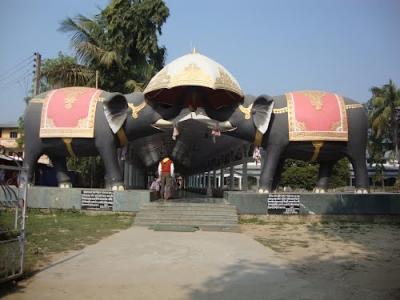|
On the death of his wife, he migrated to Bardowa (Nagaon District, present-day Assam), and married Manorama of the Bara Bhuyan clan. But due to warfare (between the Bara Bhuyans and the Kacharis) he became homeless and Harasinga Bora, an officer of the Ahom kingdom, gave him shelter at Letekupukhuri (situated between Narayanpur and Bihpuria). Madhabdev was born at Letekupukhuri and Harasinga Bora arranged for his early education at Narayanpur.
A famine induced the family to move again, and the family was given shelter by a boatman named Ghagari Maji at Habung, a place near Dhakuakhana in Lakhimpur district. Here Madhabdev's sister Urvasi was born. After about 10 years at Habung, the family rowed down the Brahmaputra river to Rauta-Tembuwani (present-day Bordowa), where Urvasi was married off to Gayapani, a Bhuyan. Soon after, Madhabdev accompanied his father back to Banduka (leaving behind his mother with his sister and brother-in-law), where he continued his education under a teacher named Rajendra Adhyapak. Here, Madhabdev became well versed in the Tantras, Tarka-shastra, Purana and other literature associated with Saktism. Soon after, his father Govindagiri died.
Leaving his half-brother (named either Damodara or Rupchandra), Madhabdev returned to his brother-in-law Gayapani with the news and stayed on involving himself with trade in betel-leaf and areca nut. When his half-brother, who was a Majinder at Banduka, fell ill Madhabdev returned there to shoulder his responsibilities. At Banduka he received news of his mother's failing health and he hastened back to Dhuwahat, where Gayapani had moved to along with his wife and mother-in-law after the Kacharis had uprooted the Bara Bhuyans.
Madhabdev had grown into a staunch sakta in his learning and practice, and on receiving news of his mother's illness while in Banduka, he resolved to sacrifice two goats to propitiate the goddess. In the meantime his brother-in-law Gayapani had converted to Ekasarana Dharma and refused to procure the goats for the sacrifice. A debate ensued and Gayapani, now named Ramadasa, took Madhabdev to meet Sankardev to discuss the conflicts. The debate continued for four and a half hour, when Sankardev uttered a sloka from the Bhagavata Purana Madhabdev was convinced and he accepted Sankardev as his guru. At the age of thirty-two, he joined his scholarship, literary and musical genius to the cause of Ekasarana dharma. Sankardev accepted him as his prana bandhava (friend of the soul), and anointed him later as his successor. Madhabdev's conversion occurred in the year 1522. After his conversion, Madhabdev broke his betrothal and resolved never to marry.
Madhabdev religiously carried forward his guru's legacy, establishing several satras (monasteries) that have served as the foundation of moderate thoughts and beliefs for centuries. Srimanta Sankardev preferred him over his two sons to carry the Vaishnavite movement forward and together they united the region from Sadiya to Cooch Behar into a composite whole with a common cultural milieu. The two gurus triggered a cultural renaissance. The satras, namghars (community prayer halls), kirtan and borgeet are there because of them,? an official of the art and culture department said.
. Because two great apostles, Srimanta Shankardeva and Madhabdev had undertakeAssam is known as the state of Ekasarana Dharman pivotal roles in Assamese literature. The Kirtan Ghosa, Dasham, Ankia Nat, Gunamala, Namghosa are the most popular and widely held books in Assam. Srimanta Sankardeva And Madhabdev has changed the literature of Assam by writing these books. The Borgeet written by both Sankardev And Madhabdev is known as the soul song of Assam. The Ankia Nat and Jumura are the first Indian cultural drama and these are acts that came before Shakespeare wrote Hamlet. Another poet named Rudra Kandali translated Drona Parva into Assamese. But the most well-known poet of the Pre-Vaishnavite sub period is Madhav Kandali, who rendered Valmiki's Ramayana into Assamese verse (Kotha Ramayana, 14th century) under the patronage of Mahamanikya, a Kachari king of Jayantapura. Madhabdev became the religious as well as artistic successor of Sankardeva after the later's death in 1568.
The famous assamese Dhekiakhowa Bornamghor was established by Madhavdeva around in 1528. A Vaishnavite lamp in Dhekiakhowa Bor Namghar lamp has been kept burning for 484 years till date. It is located at Dhekiakhowa village of Jorhat, 15 km towards the east of Jorhat town, 3.5 km away from National Highway 37. It is called a Bornamghar because of its historical association and large campus.
The Saint passed in 1596 at Bhela Satra, Koch Bihar. |



